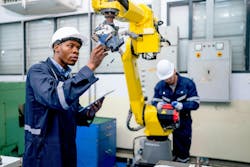ISO 10218 update makes functional-safety requirements more explicit
After nearly eight years of work, the Association for Advancing Automation (A3) published a revised ISO 10218, the global standard for industrial robot safety. In its first major revision since 2011, these new documents offer a step forward in ensuring the safety of robotics in industrial environments.
“Working alongside hundreds of global experts, A3 played a pivotal role in shepherding this update to publication, to refine safety requirements in response to evolving automation technologies and workplace demands,” said Jeff Burnstein, A3 president. “This effort reflects A3’s ongoing commitment to enhancing robotic safety and supporting the widespread adoption of automation.”
The new ISO 10218 parts 1 and 2 feature extensive updates that focus on making functional safety requirements more explicit rather than implied. This shift is designed to enhance clarity and usability to make compliance more straightforward for manufacturers and integrators alike.
In North America, ISO 10218 had been previously adopted as ANSI R15.06 in the United States and CSA Z434 in Canada. Work is underway to adopt the new 10218 in both jurisdictions with new versions of R15.06 and Z434 expected to be released later this year.
Key updates in the 2025 release of ISO 10218
ISO 10218 consists of two parts:
- Part 1: Safety Requirements for Industrial Robots (Manufacturers)
- Part 2: Safety Requirements for Industrial Robot Applications and Robot Cells (System Integrators).
Both parts have undergone extensive revisions to address safety challenges and technological advancements, including:
- clarified functional safety requirements that offer more precise safety guidelines to enhance compliance and risk mitigation
- integrated safety requirements for collaborative robot applications that consolidates the previously separate ISO/TS 15066
- incorporated safety guidance for manual load/unload procedures and end effectors, sometimes called end-of-arm tooling (EOAT) from previously separate technical reports, TR 20218-1 and TR 20218-2
- new robot classifications with corresponding functional safety requirements and test methodologies
- cybersecurity requirements pertaining to industrial robot safety.
Carole Franklin, director of standards at A3 Robotics, emphasized the significance of these updates: "With automation evolving at an unprecedented pace, it is essential that safety standards keep up with the latest advancements. This is a critical step in ensuring that, as automation grows, worker safety remains a top priority. These revisions provide clearer guidelines and new classifications that will help manufacturers and system integrators implement the latest technology for safer robotic solutions."
Impact of revised ISO 10218 on industry
"This set of safety standards has immense global acceptance, but updates were needed" said Roberta Nelson Shea, global technical compliance officer at Universal Robots and convenor of ISO TC 299 Working Group 3. "This is a pivotal moment for industrial robotics. With automation advancing at lightning speed, we need safety standards that keep pace.
“These updates bring much-needed clarity and structure, making it easier for companies to integrate robotics with confidence,” continued Nelson Shea. “Our goal has always been to ensure that innovation and safety go hand in hand. These newly revised standards deliver on that promise."
The 2025 edition of ISO 10218 is available for purchase to U.S. customers through A3. Pricing starts at $244.

